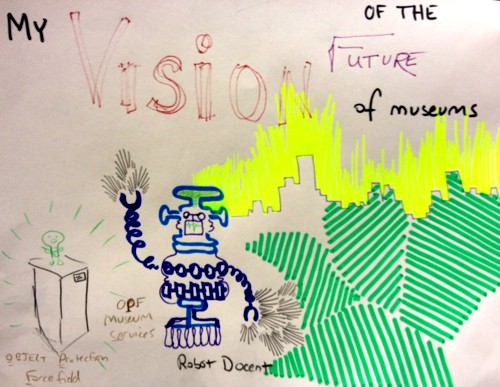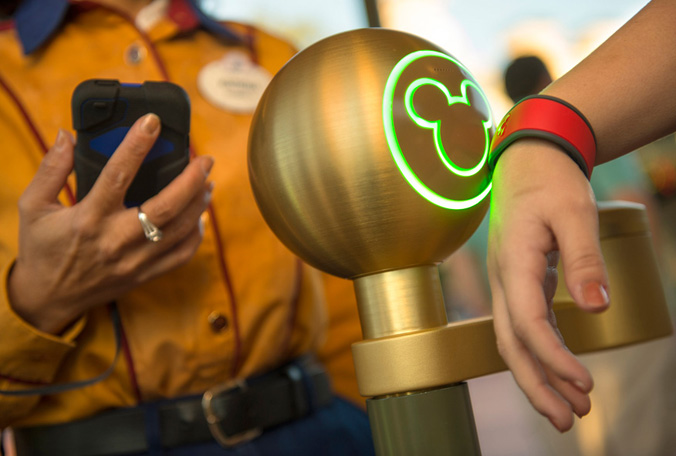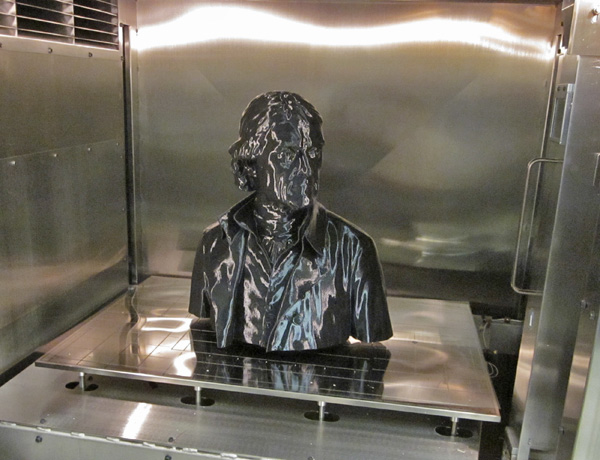
| Drawing produced by participants in the CFM “Drawing Club” event at the 2012 AAM conference |
OK, maybe not to a robot, but to increasingly sophisticated automation.
This question is prompted by a report released last month by the Associated Press, titled AP IMPACT, forecasting the effect of technology on the economy and employment.
The thesis of the authors is that the world is experiencing the first real “jobless recovery” in history, as we bounce back from the great recession of 2008. They argue that the millions of jobs that went away in the past few years, not only are not coming back, even more jobs will be lost as automation takes over more and more work. Technology isn’t just replacing factory jobs, as robots show they can build things faster and safer than their human counterparts. Technology is making inroads into solid, white collar jobs like lawyer, accountant, bank teller and manager. The AP report makes the case that while technology is creating some jobs—in software engineering, app development for example—it is eliminating many more.
The report points out that the work most likely to be automated involves processes that can be replicated via software. Paralegals used to have to read, review and tag documents—now a computer program can do that. Accounting software can keep your books. Legal and tax software can help you fill out and file simple forms. Travel agents have been rendered practically anachronistic by sites such as Orbitz and Expedia. As we increase our ability to collect and interpret data, automation will eat its way up the food chain as well. Programs could perform many management functions, such as tracking productivity, accuracy, and timeliness of work and providing assessment, feedback and recommendations for training.
The report cites Martin Ford, author of “The Lights in the Tunnel,” a book predicting widespread job losses, as saying “There’s no sector of the economy that’s going to get a pass. It’s everywhere.” No sector, eh? What about museums? What roles in the museum may be fully or partially automated, outmoded or obsolete? Here are four positions I thought of that may be reduced or made redundant by smart technology. Please agree, disagree, and add to this list in the comment section, below.
 |
| Disney MagicBand |
Front line staff: including, sales (tickets, food service, shop) and information desk. How often have you printed your own tickets at the cinema lately, checked out your own purchases at the grocery store or pharmacy, or checked out your own book at the library? Sales clerks are an increasingly rare breed. In the long run, digital tickets will perform even more functions than physical ones anyway. Disney is gearing up to automate admissions, replacing tickets with “MagicBands”: high tech wrist bands equipped with near field communication chips. The wrist band stores information of what admission privileges a visitor has bought (online) and the data on the band’s RFID chip is read by a turnstile. The band can be personalized to the user (the turnstyle can also use a biometric fingerprint scan to verify identity.) Will there come a day when instead of a membership card, you have a membership wristband for your local museum, which not only admits you to the premises, but collects information about where you go in the museum, and how long you stay?
Interpretive staff: There already are a number of robot docents being tested right now. BIB, conducts tours for visitors at the Technical Museum in Malmo, Sweden. A somewhat cuddlier robot gives tours at the Daejon Museum of Art in Korea. But the function of docents is being supplanted in a more mainstream manner by information delivered through ubiquitous internet connected mobile devices like smart phones and tablets. Integrate that with the capabilities of an artificial intelligence program such as Siri or Watson, and every visitor could have a personal digital guide through the museum. This isn’t just a matter of personalization or efficiency, either. Researchfrom Reach Advisors suggest that the majority of museum goers prefer a “self-curated” experience with no staff interaction in any case.
 |
| 3D-printed statue of Thomas Jefferson, National Museum of African American History and Culture, D.C |
Exhibit fabricators: When I worked at the Cincinnati Museum of Natural History, I used to take breaks to visit the exhibition prep areas and watch our fabricators make fabulously detailed fiberglass recreations of specimens. Now I wonder how long it will be before much of their hand-craft is replaced by equally fabulous (and possibly more accurate) 3-D printing. Here’s one example: a paleontologist from the National Museum of Brazil who recently scanned a fossil crocodile as it was excavated, and printed a 3-D model for research. Here’s another: the Smithsonian Institution sharing digital files to enable other museums to print and display copies of SI artifacts. 3-D printing aside, as the costs of various kinds of digital fabrication machinery comes down, museums that do a lot of in-house exhibit production may invest more in such equipment, and in training the few(er) staff needed to run them.
 |
| From the Hurstville LMB Blog |
Collections managers: In my earlier career, I was a collections manager, so the possibility of automating some of the responsibilities of this position strikes particularly close to home. A lot of what I did as a collections manager involved keeping records, tracking objects, monitoring storage conditions—uh oh, this sounds a lot like the functions the AP article documents being automated across many industries. RFIDs are already being used for collections tracking (see, for example, this presentation by Jessica Allen, Curator at the Hurstville City Library, Museum & Gallery). The Louvre has already created a smart building environment that self-monitors and adjusts climate control in response to internal feedback. It’s only a short step from this to an internal museum “internet of things” in which the collections communicate their positions and needs to the building controls and the remaining staff. Soon every object in the collection may be tagged with an RFID chip or other near field communication device that reports on its position, communicates with the nearby RH/T° monitor and the bug monitor (which “sniffs” for signs of frass or other insect traces), checks the object’s environmental preferences, adjusts the climate control as necessary or reports to the (remaining) collections staff any other action that needs to be taken.
Do I see museums laying off staff because they are automating? No. Museums staff are pretty “mean and lean” to begin with But the 2012 National Comparative Museum Salary Study documents the recent downsizing of the field. Significantly more museums saw their staff size decline than grow between 2008 and 2010: almost 60% of museums with operating budgets over $3M experienced a net decline in staffing. I think it quite plausible that as the costs of various technologies drop, and the economic recovery enables museums to ramp up their operations, they may invest some of that recovered money in technology instead of staff. What do you think?
You can access the AP report here:
Part 1: Recession, tech kill middle-class jobs
Part 2: Practically Human: Can smart machines do your job?
Part 3: Will smart machines create a world without work?









Front of house – Museum of Math (MoMATH) in NYC now has purchase your own ticket kiosks like airline check-in terminals instead of ticket staff and a ticket desk.
And the robot tour guides are closer than we all think, driven most probably by the opportunities they also afford for remote visiting and distance learning. (see May 2012)
Great work,like the post.
What to Invest